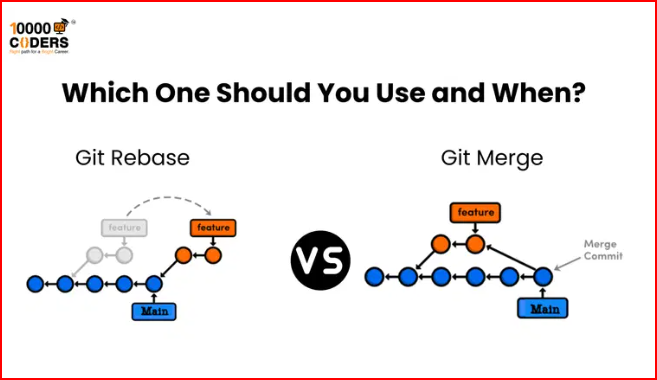Git Rebase vs Git Merge: Which One Should You Use and When?
A detailed guide to understanding the differences between Git rebase and merge, helping you make informed decisions for your version control workflow.
Understanding the Basics
Git Merge
Before Merge
main A---B---C
\
feature D---E
After Merge
main A---B---C---F
\ /
feature D---E
Key Characteristics
- Creates a new merge commit
- Preserves complete history
- Non-destructive operation
- Maintains branch context
- Safe for shared branches
Git Rebase
Before Rebase
main A---B---C
\
feature D---E
After Rebase
main A---B---C
\
feature D'---E'
Key Characteristics
- Linear project history
- Clean commit history
- Rewrites commit history
- No merge commits
- Better for local branches
Key Differences
1. History Structure
Merge
- Preserves branch history
- Shows when branches were created
- Maintains context of parallel development
- Creates a merge commit
Rebase
- Creates linear history
- Hides when branches were created
- Appears as if work was done sequentially
- No merge commits
2. Commit History
Merge
# Merge commit message
Merge branch 'feature' into main
# Commit history
A---B---C---F (main)
\ /
D---E (feature)
Rebase
# Commit history
A---B---C---D'---E' (main)
3. Use Cases
When to Use Merge
- Public/shared branches
- Preserving branch history
- Complex feature branches
- Team collaboration
When to Use Rebase
- Local feature branches
- Clean project history
- Before merging to main
- Individual development
Implementation Examples
Git Merge
# Basic merge
git checkout main
git merge feature
# Merge with no fast-forward
git merge --no-ff feature
# Merge with specific strategy
git merge -X theirs feature
Git Rebase
# Basic rebase
git checkout feature
git rebase main
# Interactive rebase
git rebase -i HEAD~3
# Rebase with conflict resolution
git rebase --continue
git rebase --abort
Best Practices
Merge Best Practices
- When to Use
- Merging feature branches
- Preserving history
- Team collaboration
- Public repositories
- How to Use
- Use
--no-fffor feature branches - Write clear merge messages
- Resolve conflicts carefully
- Keep branches up to date
Rebase Best Practices
- When to Use
- Local development
- Before merging to main
- Cleaning up commits
- Maintaining linear history
- How to Use
- Don't rebase public history
- Use interactive rebase
- Test after rebasing
- Keep backups
Common Scenarios
Scenario 1: Feature Development
# Using merge
git checkout main
git merge feature
# Using rebase
git checkout feature
git rebase main
git checkout main
git merge feature
Scenario 2: Updating Feature Branch
# Using merge
git checkout feature
git merge main
# Using rebase
git checkout feature
git rebase main
Scenario 3: Cleaning Up Commits
# Interactive rebase
git rebase -i HEAD~3
# Squash commits
pick abc1234 First commit
squash def5678 Second commit
squash ghi9012 Third commit
Potential Issues
Merge Issues
- Merge Conflicts
- Complex resolution
- Multiple conflict points
- History preservation
- Team coordination
- History Clutter
- Merge commits
- Branch complexity
- Hard to follow
- Visual noise
Rebase Issues
- History Rewriting
- Lost context
- Force push needed
- Team coordination
- Backup required
- Conflict Resolution
- Sequential conflicts
- Multiple resolutions
- Complex scenarios
- Time-consuming
Team Guidelines
When to Choose Merge
- Team Collaboration
- Shared branches
- Public repositories
- Team coordination
- History preservation
- Project Requirements
- Complex features
- Long-lived branches
- Multiple developers
- Release management
When to Choose Rebase
- Individual Work
- Local development
- Feature branches
- Code cleanup
- History maintenance
- Project Standards
- Linear history
- Clean commits
- Code review
- Quality control
Advanced Techniques
Merge Strategies
# Recursive merge
git merge -X recursive feature
# Octopus merge
git merge feature1 feature2
# Ours/Theirs
git merge -X ours feature
git merge -X theirs feature
Rebase Techniques
# Interactive rebase
git rebase -i HEAD~3
# Rebase with autosquash
git rebase -i --autosquash HEAD~3
# Rebase with preserve-merges
git rebase -p main
Decision Framework
Choose Merge When
- Working on shared branches
- Preserving branch history
- Complex feature development
- Team collaboration
Choose Rebase When
- Working on local branches
- Maintaining clean history
- Before merging to main
- Individual development
Conclusion
Both merge and rebase are valuable tools in Git. The choice depends on:
- Team workflow
- Project requirements
- History preferences
- Collaboration needs
- Development style
Next Steps
- Evaluate your workflow
- Set team guidelines
- Practice both methods
- Monitor effectiveness
- Adjust as needed
Resources
Citations
🚀 Ready to kickstart your tech career?
🎓 [Learn Web Development for Free]
🌟 [See how we helped 2500+ students get jobs]





Comments